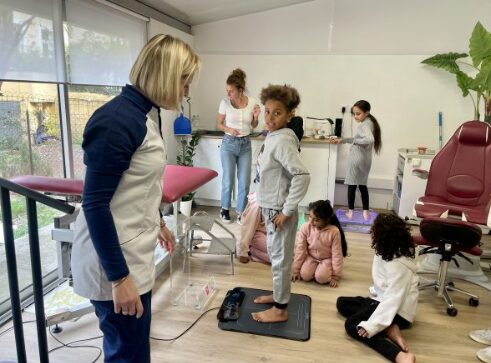Doctors, artisans, merchants, police officers, maintenance workers, and citizens become teachers for a few hours for the children of neighboring schools thanks to 'Quartier école' (School District). This unique initiative, implemented since November 2023 by La Fabrique du Nous and supported by Bayard Press Group, is being tested in three pilot classes in Marseille.
The Bernard Cadenat Elementary School is located in the heart of Belle de Mai, one of the poorest neighborhoods in Marseille, France. However, it is the first in France to host "Quartier école," the latest initiative by La Fabrique du Nous, a project and idea lab based in Marseille. Committed to a more fraternal society, its founders, Nathalie Gatellier and Tarik Ghezali, drew inspiration from projects developed in Brazil and Naples to combat school failure. For a year, primary school students had classes outside the school, at various businesses in the neighborhood.
A skeleton to tame anatomy
That morning, they were welcomed at the neighboring podiatry office of their school. None of them knew the place, let alone the profession. They all face the skeleton Oscar, proud and upright on its stand. The podiatrist starts by talking to them about joints. She asks the ten children present to show their neck, knees, feet, ankles, or hips one by one.
The elementary school teacher never fails to connect the information to her classes and encourage the younger, more intimidated ones to participate. "Loulou, when we do sports in the morning, what do we warm up?" asks Mathilde Adam to a little boy who doesn't let go of the skeleton's hand. This preparatory class teacher mixes her students with those of the middle school teacher to get two groups. "The interaction between the young and the older ones is always interesting. The younger ones gain confidence and discover the older ones. In the playground, ages do not mix".

The podiatrist continues the session with the muscles, suggests to the children to take off one shoe to touch the heel, "you will see that it's all hard." Then the sole, "it's the belly of the foot," replies a little girl. A nice word to indicate "the sole of the foot," says Mathilde Adam. And she adds that the arch, "it's the plantar vault." Isaac, a very participative 5th grade student, points out the ribs. Kemis didn't know "there were so many." Then the students touch their kneecaps to discover that they move. Finally, they make an imprint of their foot or hand with ink, on the podograph. A nice memory that they can take home with them.
A concrete learning
The children are delighted with the session. Kubra did not know that the part under the foot "is called arch", Adam that "feet have many bones and that there are also bones in the knees". And Mohamed, that the elbow, "it was a joint". This possibility of learning from professionals brings "another perspective of learning for the students", insists Christelle Ribes, volunteer project manager of 'Quartier école'.
The younger ones deepen and enrich their vocabulary, while the older ones solidify the concepts taught in class - here, anatomy. Math and history are practiced in other places. Thus, at the Gyptis cinema, students discussed the Second World War - as the building was partly destroyed in 1944. And geometry around the big screen - calculating width, height, and length.
Valuing other knowledge
This new approach, less formal, offers students a different way to participate in class. A shy student, who does not dare to raise their hand or go to the board, can come out of their shell. Like this little Romanian girl, who arrived in France four years ago, "rather failing in school".
When her class had a lesson with the gardener of Couvent Levat, an artists' residence, the little girl already knew how to take care of the land - it was about weeding. "She was in her element, you could see that she enjoyed it. She was no longer the same child," remembers Christelle Ribes. These qualities enhanced her skills, for her, but also in the eyes of her teacher and her classmates.
Municipal Archives, Grocers, Road maintenance workers...
"School district" offers children the opportunity to learn about surrounding shops and cultural places, but also to navigate through the city. For shop owners, it's "a breath of fresh air in their day," notes Christelle Ribes.
The bright young woman is also delighted for her neighborhood which, she believes, lacks dynamism. 'School district' is, she hopes, a way to build connections. Soon, there will also be the Municipal Archives of the city, where children will learn how to read a map and navigate in space. The visit will continue with the discovery of ancient documents and a workshop introducing calligraphy and illumination. She plans to take the classes to a community grocery store, to learn about weights - grams and kilos - using a weighing scale. And calculations with the cash register. They will then go next door to the Cantine de Midi, to learn about seasonal products during a cooking workshop.
Multiply the schools
All professionals in the neighborhood are potential sources of learning. Thus, urban cleanliness agents - more commonly known as garbage collectors - could very well introduce the group to the waste cycle. They have indeed explained that this initiative will give "meaning to their profession," reports the volunteer. She plans to expand "Quartier école" to other establishments starting next September.
